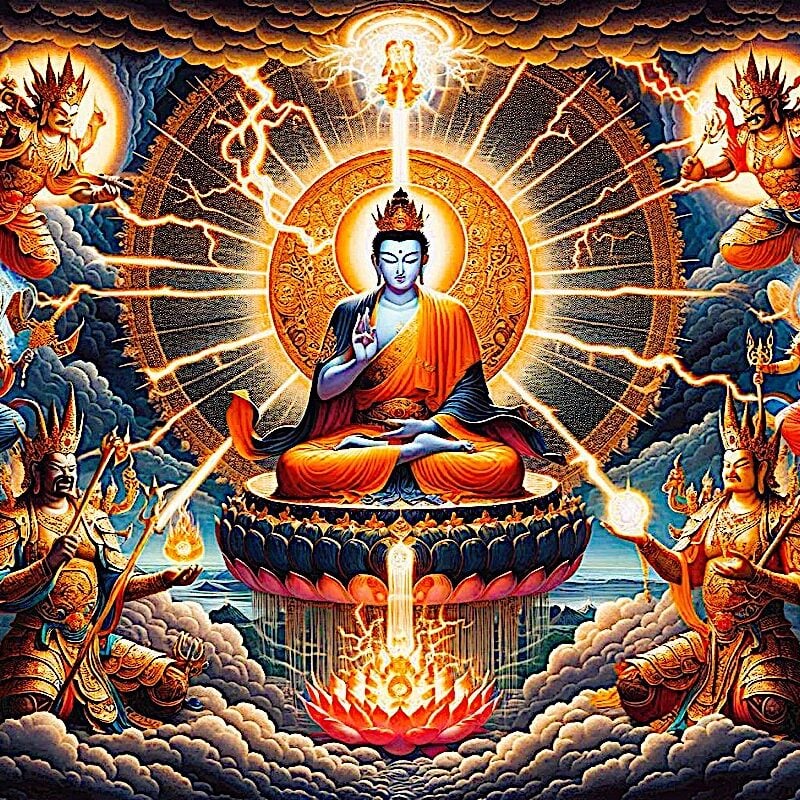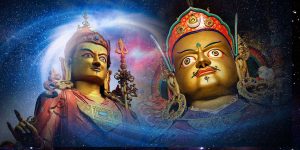Yodhajiva Sutta — the warrior Sutta? The four great qualities of the warrior compared to the qualities of the monk: full English
The so-called Warrior Sutta is a fascinating, short sutra. The way of the warrior and the way of the monk are often compared from the point of view of discipline. In Tibetan Buddhism, there is the notion of Sems Dpa, Warrior Buddhists (se our feature here>>).
The disciplines of martial arts, today, are often compared to methods in Buddhism. [See our feature here Marital Arts and Buddhism have this in common>>]
In this Sutra, Buddha teaches the monks with the metaphor of the Warrior.
Yodhajiva Sutta The Warrior
“Endowed with four qualities, monks, a warrior is worthy of a king, an asset to a king, and counts as a very limb of his king. Which four?
“There is the case where a warrior is skilled in his stance, able to shoot far, able to fire shots in rapid succession, and able to pierce great objects. A warrior endowed with these four qualities is worthy of a king, an asset to a king, and counts as a very limb of his king.
“In the same way a monk endowed with four qualities is deserving of gifts, deserving of hospitality, deserving of offerings, deserving of respect, an unexcelled field of merit for the world. Which four?
“There is the case where a monk is skilled in his stance, able to shoot far, able to fire shots in rapid succession, and able to pierce great objects. A monk endowed with these four qualities is deserving of gifts, deserving of hospitality, deserving of offerings, deserving of respect, an unexcelled field of merit for the world.
“And how is a monk skilled in his stance? There is the case where a monk is virtuous. He dwells restrained in accordance with the Patimokkha, consummate in his behavior and sphere of activity. He trains himself, having undertaken the training rules, seeing danger in the slightest faults. This is how a monk is skilled in his stance.
“And how is a monk one who is able to shoot far? There is the case where a monk sees any form whatsoever that is past, future, or present; internal or external; blatant or subtle; common or sublime; far or near — every form — as it actually is with right discernment as: ‘this is not mine. This is not my self. This is not what I am.’
“He sees any feeling whatsoever…
“He sees any perception whatsoever… “He sees any fabrications whatsoever…
“He sees any consciousness whatsoever that is past, future, or present; internal or external; blatant or subtle; common or sublime; far or near — every consciousness — as it actually is with right discernment as: ‘this is not mine. This is not my self. This is not what I am.’
“This is how a monk is one who is able to shoot far.
“And how is a monk one who is able to fire shots in rapid succession? There is the case where a monk discerns, as it actually is present, that ‘This is stress.’… ‘This is the origination of stress.’… ‘This is the cessation of stress.’… ‘This is the path of practice leading to the cessation of stress.’ This is how a monk is one who is able to fire shots in rapid succession.
“And how is a monk one who is able to pierce great objects? There is the case where a monk pierces right through the great mass of ignorance. This is how a monk is one who is able to pierce great objects right through.
“Endowed with these four qualities, a monk is deserving of gifts, deserving of hospitality, deserving of offerings, deserving of respect, an unexcelled field of merit for the world.”
More articles by this author

Protection from all Harm, Natural Disaster, Weather, Spirits, Evil, Ghosts, Demons, Obstacles: Golden Light Sutra: Chapter 14

Samantabhadra’s The King of Prayers is the ultimate Buddhist practice how-to and itself a complete practice

The Five Strengths and Powers or pañcabalā in Buddhism — the qualities conducive to Enlightenment: faith, energy, mindfulness, concentration and wisdom
Search
Latest Features
Please support the "Spread the Dharma" mission as one of our heroic Dharma Supporting Members, or with a one-time donation.
Please Help Support the “Spread the Dharma” Mission!

Be a part of the noble mission as a supporting member or a patron, or a volunteer contributor of content.
The power of Dharma to help sentient beings, in part, lies in ensuring access to Buddha’s precious Dharma — the mission of Buddha Weekly. We can’t do it without you!
A non-profit association since 2007, Buddha Weekly published many feature articles, videos, and, podcasts. Please consider supporting the mission to preserve and “Spread the Dharma." Your support as either a patron or a supporting member helps defray the high costs of producing quality Dharma content. Thank you! Learn more here, or become one of our super karma heroes on Patreon.
Lee Kane
Author | Buddha Weekly
Lee Kane is the editor of Buddha Weekly, since 2007. His main focuses as a writer are mindfulness techniques, meditation, Dharma and Sutra commentaries, Buddhist practices, international perspectives and traditions, Vajrayana, Mahayana, Zen. He also covers various events.
Lee also contributes as a writer to various other online magazines and blogs.















